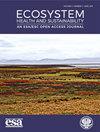海洋热排放与核电站周围野村线虫繁殖之间的联系
IF 3.4
2区 环境科学与生态学
Q1 ECOLOGY
引用次数: 1
摘要
最近的研究表明,水母华更频繁地发生在核电站(NPPs)附近,并且已经假设了核电站的热排放与水母华之间的关系。然而,没有直接的证据表明热排放与水母繁殖有关。在这项研究中,我们于2017年7月至9月在中国北方最大的核电站周围地区进行了3次巡航(花期前、花期和花期后)。冷却水出水口附近水温上升2℃。虽然我们没有发现对排水口附近浮游植物丰度或群落组成的显著影响,但对监测数据的更广泛分析显示,温度与野线虫、蓝藻和触生菌的丰度之间存在显著相关性。温度升高可能对水母生活史的关键阶段产生刺激作用,水母猎物的丰富可能是触发水母繁殖的因素。水母的大量繁殖伴随着硅藻优势度的下降和蓝藻、共生藻等小型浮游植物浓度的增加。本研究首次揭示了水母丰度与溶解有机营养物浓度呈显著正相关(r2 = 0.39, P < 0.001)。这种相关性表明,水母的大量繁殖导致了大量有机营养物质的释放。研究结果提供了一个全面的视角,并表明需要进一步研究浮游生态系统的动态,以联系热排放和水母华。本文章由计算机程序翻译,如有差异,请以英文原文为准。
The Link Between Marine Thermal Discharges and
Nemopilema Nomurai
Blooms Around Nuclear Power Plants
Recent research has shown that jellyfish blooms occur more frequently near nuclear power plants (NPPs), and a relationship between thermal discharges from the NPPs and the blooms has been hypothesized. There is, however, no direct evidence that links the thermal discharges with jellyfish blooms. In this study, we conducted 3 cruises (pre-bloom, bloom, and post-bloom) during July to September 2017 in the area surrounding the largest NPP in northern China. The water temperature near the cooling water outfall rose by 2 °C. Although we found no significant impact on phytoplankton abundance or community composition near the outfall, a broader analysis of monitoring data revealed significant correlations between temperature and the abundance of
Nemopilema nomurai
, cyanobacteria, and haptophytes. Temperature increases may have a stimulatory effect on key stages in the life history of jellyfish, and the abundance of jellyfish prey may be the factor that triggers jellyfish blooms. Blooms of jellyfish were accompanied by a decline of diatom dominance and an increase of the concentrations of small phytoplankton such as cyanobacteria and haptophytes. This study revealed for the first time a significant positive correlation (
R
2
= 0.39,
P <
0.001) between jellyfish abundance and concentrations of dissolved organic nutrients. This correlation suggested that the blooms of jellyfish resulted in the release of large amounts of organic nutrients. The results provided a comprehensive perspective and suggested a need for further study of the dynamics of planktonic ecosystems to link thermal discharges and jellyfish blooms.
求助全文
通过发布文献求助,成功后即可免费获取论文全文。
去求助
来源期刊

Ecosystem Health and Sustainability
Environmental Science-Management, Monitoring, Policy and Law
CiteScore
7.10
自引率
2.00%
发文量
40
审稿时长
22 weeks
期刊介绍:
Ecosystem Health and Sustainability publishes articles on advances in ecology and sustainability science, how global environmental change affects ecosystem health, how changes in human activities affect ecosystem conditions, and system-based approaches for applying ecological science in decision-making to promote sustainable development. Papers focus on applying ecological theory, principles, and concepts to support sustainable development, especially in regions undergoing rapid environmental change. Papers on multi-scale, integrative, and interdisciplinary studies, and on international collaborations between scientists from industrialized and industrializing countries are especially welcome.
Suitable topics for EHS include:
• Global, regional and local studies of international significance
• Impact of global or regional environmental change on natural ecosystems
• Interdisciplinary research involving integration of natural, social, and behavioral sciences
• Science and policy that promote the use of ecological sciences in decision making
• Novel or multidisciplinary approaches for solving complex ecological problems
• Multi-scale and long-term observations of ecosystem evolution
• Development of novel systems approaches or modeling and simulation techniques
• Rapid responses to emerging ecological issues.
 求助内容:
求助内容: 应助结果提醒方式:
应助结果提醒方式:


